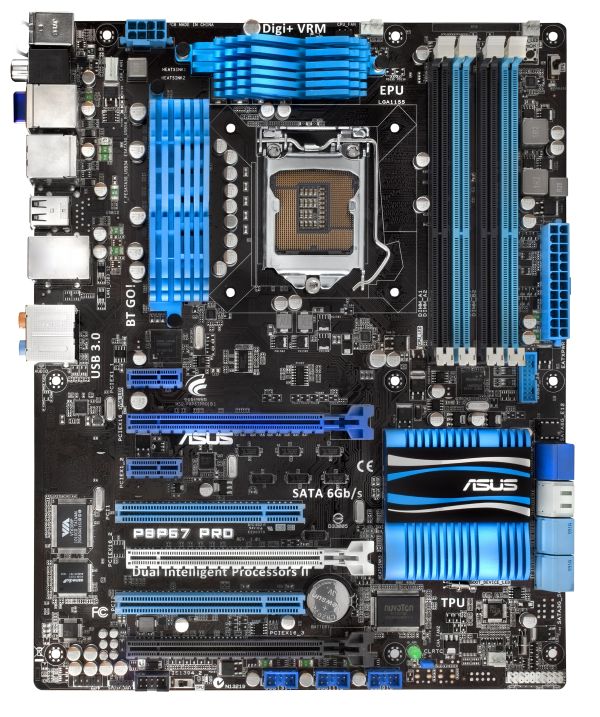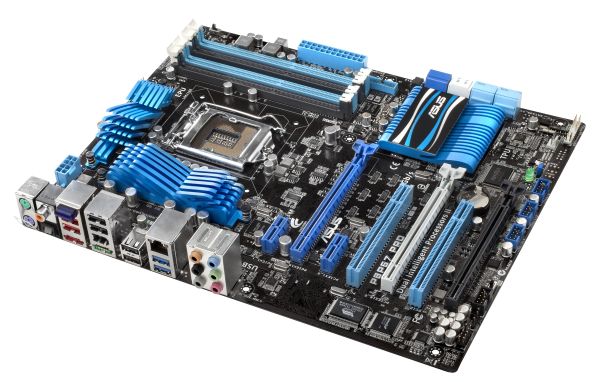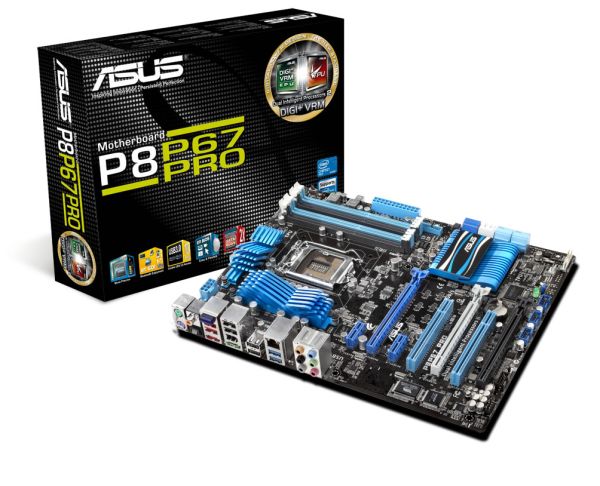The Battle of the P67 Boards - ASUS vs. Gigabyte at $190
by Ian Cutress on January 20, 2011 4:15 PM EST- Posted in
- Motherboards
- Gigabyte
- Asus
- P67
The ASUS P8P67 Pro fits near the beginning of the line-up in the ASUS launch, which in terms of ATX sized boards include the P8P67, the P8P67 Pro, the P8P67 Evo, the P8P67 Deluxe, the Sabertooth P67, the P8P67 WS SuperComputer and the top end Maximus IV Extreme. Therefore, with that in mind, we would expect to be looking at something above the base – slightly more (or better) features than the cheap boards available, enough to warrant the price difference. An overview of the P8P67 series is below:
| P8P67 Series | ||||||
| P8P67 LE | P8P67 | P8P67 PRO | P8P67 EVO | P8P67 Deluxe | ||
| Price | $140 | $160 | $190 | $210 | $235 | |
|
SATA 6 Gb/s SATA 3 Gb/s eSATA |
3 4 1 |
4 4 1 (bracket) |
4 4 2 |
4 4 2 |
4 4 2 |
|
|
CrossFireX SLI |
Yes No |
Yes No |
Yes Yes |
Yes Yes |
Yes Yes |
|
|
USB 3.0 USB 2.0 |
2 14 |
4 (2 via header) 12 |
||||
| LAN | 1 | 1 | 1 | 2 | 2 | |
| Bluetooth | No | Yes | Yes | Yes | Yes | |
Visual Inspection
ASUS have gone with the blue/white/black livery for the Pro board, with a 12+2 digital VRM design covered by slanted blue heat sinks. The socket itself is relatively clear, easily allowing large 1155/1156 CPU coolers to be fitted (remember, 1155 mounting holes are the same as 1156). The CPU fan header is located at roughly one o’clock from the socket itself, with a chassis header to the right of the DIMM slots, presumably for HDD bay type fans.
Next to this header are the EPU switch and the MemOK buttons. The EPU switch enables Energy Processing Unit, which is geared towards saving energy – this encompasses power gating certain features that are never used/used rarely, and declocking when less compute is required. The MemOK button is a physical override for overclocked memory – by holding it down until the red light comes on, at next boot, the UEFI will override the memory settings to something more suitable.
The SATA connectors come in blue (SATA 3 Gb/s), white/grey (SATA 6 Gb/s provided by the chipset) and navy blue (SATA 6 Gb/s provided by a Marvell controller). There is a USB 3.0 header also here, near the DIMM slots. These are all next to the ASUS logo and chipset cooler, which underneath have another chassis header and a green power light. This board is lacking both a debug LED and power/reset buttons on the main board, much to our disappointment.
The PCI slots are well laid out, with a PCIe 1x at the top and enough space between the first two PCIe x16 for a PCI card, meaning that at least one is available if all three PCIe x16 are occupied with dual slot cards. The black PCIe x16 slot is wired up as an x4 slot (as it shares bandwidth with the x1 slots, two USB 3.0 ports and the eSATA ports), and with a dual slot card in there, will cover most of the board USB headers.
The TPU switch is underneath the PCI slots, and performs the same function as the TurboV EVO software in the OS to optimise the system for a decent and stable overclock.
The back panel is standard, with dual PS/2 connectors, SPDIF outputs, USB 2.0 slots, USB 3.0 slots, Firewire, eSATA, audio and Ethernet. The blue module three from the left is the ASUS Bluetooth module, designed to communicate with Bluetooth devices to enhance overclocking or utilise music management. The gigabit Ethernet is handily powered by an Intel chip.














137 Comments
View All Comments
erple2 - Friday, January 21, 2011 - link
Technically, there has simultaneously always and never been a "perfect storm" of price and performance. Things always get faster at the same price point over time.As a commenter above pointed out, while these machines may be able to decode stuff quickly (and I'm guessing the 2600k will be faster), when their "system price" comes down to whatever sweet spot you are targeting, we'll have additional things we want to do with our computers (3D movies, 4K HD, 8K hD etc) that will tax these beyond what we consider "reasonable" today.
Ultimately, things ALWAYS get cheaper for the same level of performance and/or do more with the same cost. That's what progress "mandates". Unfortunately, we demand more things to be done, so the perceived amount of extra work you can do never really seems to go down. I used to be happy running a 386-DX40 in the DOS days. Things seemed fast and speedy then. I acknowledge that I do more today than I did back then, though I'm not sure if that's because the software does more, rather than I do more.
My advice - pick a budget and when you can no longer reasonably do what you now do, then buy with an eye to the future. I picked a fairly high budget, but I wanted to get a 'significant' upgrade that would still be usable 3 years in the future. My Core2Duo lasted from 2007 until the end of 2010, when I (foolishly) bought an i7-950.
marc1000 - Friday, January 21, 2011 - link
and in the 067 boards we can't use the encoding abilities from Sandy Bridge, because the on-chip GPU is turned-off in this chipset. so the only value in $150 boards is x8/x8 PCIe (cheaper boards cut this to x16/x4, a stupid thing but the only way to force us to spend more).medi01 - Saturday, January 22, 2011 - link
Which "encoding abilities" are we talking about, please? Shamelessly hyped increased speed, achieved at the cost of quality loss, eh?Beenthere - Thursday, January 20, 2011 - link
Asus has a long history of delivering half-baked goods - which this review confirms has happened once again. That and the fact that Asus provides zero customer support in my and many other customer's experience, means I'll vote with my wallet and get the Gigabyte mobo. I know the Asus fanbois will ignore the product defects and buy the Asus mobo anyway because of some review which shows it will OC by 2 Hz. more or something insignificant. This is how Asus dupes the naive kids.Rick83 - Thursday, January 20, 2011 - link
Well, I'm monitoring the Gigabyte boards, and there's the same image as you'd expect from the ASUS side. Plus with the weird BIOS-flash thing happening on all the boards, and the features that are missing on the Gigabyte boards, I think I'll take an ASUS this time around. (Though any board will be a step down from my brilliant IP35 Pro.... RIP ABIT)Digital Audio Inputs seem to have died out completely....
In the end, I think I'll go with the microATX ASUS in the new Fortress FT3 by Silverstone...
SmCaudata - Thursday, January 20, 2011 - link
I want to do the same build. I'm hoping for a new GENE or equivalent ASrock board. The FT3 looks like it can handle SLI well. Would be fun to build that powerful of a system in w small package and still have awesome thermals.Gothmoth - Thursday, January 20, 2011 - link
gigabyte boards make way more trouble then asus boards.don´t remind me on the samsung drives or hitachi drives that would not work for 8 month with gigabyte boards.
take a look at gigabytes support forum and you will see how "happy" the gigabyte users are. LOL.
milkyway4me - Thursday, January 20, 2011 - link
Asus does advance RMA, gigabyte doesn't. That and that alone, is why any reasonable person should choose Asus barring some massive issue that sticks out to them.Duwelon - Thursday, January 20, 2011 - link
And i've had the exact experience with Asus and Gigabyte. Last 3 computers I built all used Gigabyte board. 1 bad video card (fanless gigabyte 4550 and they replaced it with a geforce 9600gt with a fan... gee thanks for the downgrade in performance and features and upgrade in noise, thanks so very much). 1 Gigabyte board is acting up, the NIC keeps disappearing without a trace, had to install a PCI NIC to keep it on the network. I friggin hate Gigabyte's RMA process, but they're still better than some i've had to use. Asus, never had a problem with their RMA and they were a little faster than Gigabyte from what I remember. To each their own, sadly they both have flaws and neither are much better than the other. Overall though, given my recent screwing over by Gigabyte and recent issues, my pendulem is swinging towards Asus again.seamusmc - Friday, January 21, 2011 - link
I've had boards from all major vendors, ASUS, Intel, Gigabyte, Abit, DFI, etc. They've all had duds and they've all had great boards. I currently have 4 ASUS x48 Rampage's, (Home Server, Work, Wife and Game), and it is one of my favorites among many favorites. ASUS CULV is another stand out in my memory.In my experience, ASUS hasn't delivered more half-baked goods then anyone else.
Right now, it seems to me all the boards are having issues and that's to be expected with a new chipset. This is why I decided last month, despite my unquenchable hunger to upgrade, to wait at least until Feb to upgrade. At this point I may wait until March.